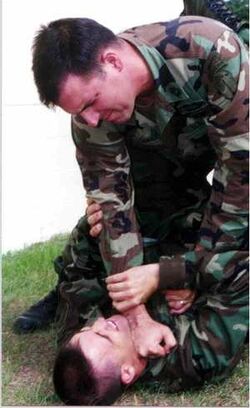Close quarters combat (nonfiction): Difference between revisions
(Created page with "'''Close quarters combat''' (CQC) is a tactical concept that involves physical confrontation between several combatants. == Description == It can take place between military...") |
|||
| (2 intermediate revisions by the same user not shown) | |||
| Line 1: | Line 1: | ||
'''Close quarters combat''' (CQC) is a tactical concept that involves physical confrontation between several combatants. | [[File:Chokehold.jpg|250px|thumb|The chokehold demonstrated in hand-to-hand combat training.]]'''Close quarters combat''' (CQC) is a tactical concept that involves physical confrontation between several combatants. It can take place between military units, police and criminals, and other similar scenarios. | ||
In [[War (nonfiction)|warfare]], it usually consists of small units or teams engage the enemy with personal weapons at very short range, up to 100 meters, from proximity hand-to-hand combat to close-quarter target negotiation with short-range firearms. | |||
In [[ | |||
In the typical close quarters combat scenario, the attackers try a very fast, violent takeover of a vehicle or structure controlled by the defenders, who usually have no easy way to withdraw. | In the typical close quarters combat scenario, the attackers try a very fast, violent takeover of a vehicle or structure controlled by the defenders, who usually have no easy way to withdraw. | ||
| Line 15: | Line 11: | ||
Criminals sometimes use close quarters combat techniques, such as in an armed robbery or jailbreak, but most of the terminology comes from training used to prepare soldiers, police, and other authorities. | Criminals sometimes use close quarters combat techniques, such as in an armed robbery or jailbreak, but most of the terminology comes from training used to prepare soldiers, police, and other authorities. | ||
== In the News == | |||
<gallery mode="traditional"> | |||
</gallery> | |||
== Nonfiction cross-reference == | == Nonfiction cross-reference == | ||
* [[ | * [[Crime (nonfiction)]] | ||
* [[War (nonfiction)]] | |||
* [[Weapon (nonfiction)]] | |||
== Fiction cross-reference == | == Fiction cross-reference == | ||
* [[Rapunzel]] | * [[Rapunzel]] - expert in close quarters combat | ||
* [[Retractable hair]] | * [[Retractable hair]] - useful in CCC situations | ||
External links: | |||
* [https://en.wikipedia.org/wiki/Close_quarters_combat Close quarters combat] @ Wikipedia | * [https://en.wikipedia.org/wiki/Close_quarters_combat Close quarters combat] @ Wikipedia | ||
[[Category:War (nonfiction)]] | [[Category:War (nonfiction)]] | ||
Latest revision as of 11:34, 24 June 2016
Close quarters combat (CQC) is a tactical concept that involves physical confrontation between several combatants. It can take place between military units, police and criminals, and other similar scenarios.
In warfare, it usually consists of small units or teams engage the enemy with personal weapons at very short range, up to 100 meters, from proximity hand-to-hand combat to close-quarter target negotiation with short-range firearms.
In the typical close quarters combat scenario, the attackers try a very fast, violent takeover of a vehicle or structure controlled by the defenders, who usually have no easy way to withdraw.
Because enemies, hostages/civilians, and fellow operators can be closely intermingled, close quarters combat demands a rapid assault and a precise application of lethal force.
The operators need great proficiency with their weapons, and the ability to make split-second decisions in order to minimize accidental casualties.
Criminals sometimes use close quarters combat techniques, such as in an armed robbery or jailbreak, but most of the terminology comes from training used to prepare soldiers, police, and other authorities.
In the News
Nonfiction cross-reference
Fiction cross-reference
- Rapunzel - expert in close quarters combat
- Retractable hair - useful in CCC situations
External links:
- Close quarters combat @ Wikipedia
